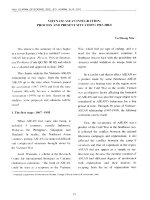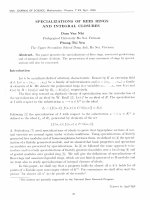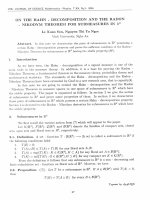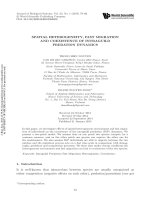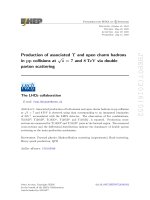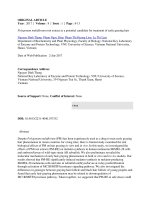DSpace at VNU: Generalized Xafs Cumulant Theory and a new Procedure for Structural Determination
Bạn đang xem bản rút gọn của tài liệu. Xem và tải ngay bản đầy đủ của tài liệu tại đây (2.46 MB, 7 trang )
VNU JOURNAL OF SCIENCE. Mathematics - Physics T . XVIII. N()2 - 2002
G E N E R A L IZ E D X A F S C U M U L A N T T H E O R Y A N D A N E W
P R O C E D U R E F O R S T R U C T U R A L D E T E R M IN A T IO N
Nguyen Van Hung
D cịìcìi ' men I o f Physics, C olleg e o f Science ‘ V N Ư
Abstract: /1 n.('ii) yc.ncrulizcd X A F S cum ulant theory has l)('
sm all atom ic rlu strr. l)Ịị I (I ki ll (Ị into account the co n trib u tio n s o f th eir immediate
neighbors to tins vibration the atom ic d is trib u tio n o r strue.iure. is considered and a
n rw structural param eter has been derived which has the value 3 f o r fee and 5 / 3 f o r
bcc crystals. N u m e ric a l calculations f o r several fee and her crystals have been carted
out. The good (UỊĨVCĨIH nt between theoretical and ex jierim en tal values denotes the
advantages o f p r c s a it new procvAurt f o r determ ina tio n o f th erm od y n a m ic properties
and structure o f the crystals.
I. Introduction
X-ray Absorption Filin Structure (X A F S ) becom es a powerful structural analysis
technique in which the XAFS functions provide information oil atomic number of each
shell, and their Foulin' transform magnitudes provide information on radius of atomic
shell [lj. But, as the U'luprnii UIV increases the uncertainties can appear in the information
OI1 the shell radius [2.3] rind on thí' atomic number of the shell [4]. Mo r('Over, still no exact
method for determination of atomic distribution has been formulated. To interpret the
uncertainties in the information oil shell radius and to fit the XAFS spectra the cumulant
expansion approach 1 iia> boon developed according to which the XAFS functions contain
thí' cumulants. Therefore, to calculate lngh-temperature XAFS spectra the cumulant
calculation procedure» is necessary. Ill the efforts for cumulant calculation the anhannonic
correlated Einstein modi'! [5' has corrected some limitations of the anharmonic single
pnrtick' potential [()|, of the «inharmonic single bond potential |7j, and of the full lattice
dynamical calculation [8 Ị, hut it was applied only for fee [5] or for bee crystals (9Ị.
This work is our development of a generalized model to overcome both the above
mentioned uneetaintirs in I hr shrll radius and in the' atomic: number of the shell. Our
derivation is based on quantum statistical theory for the anharmonic vibration between
absorbing and backscat tering atoms in a small cluster. The obtained expressions of cu
mulants are valid for low and high temperatures as well as for different structures which
are determined by a now structural parameter. By extracting this parameter from the
measured cumulants one can define the structure of the crystal. Numerical calculations
have been carried out tor si'ViTcil fee and bcc crystals showing a good agreement between
our theoretical results and the experimental values.
25
N guyen
•26
Van H unq
II. T h e o r y
In this model we consider anharmonic vibration between absorbing and backseattering atoms with contributions of their immediate neighbors so that their interaction is
characterized by an effective anharmonic potential:
Uej j (x)
H” •••
—
J
X
7
Ĩ*Q,
( 1)
where r is spontantaneous bond length between absorbing and backscattering atoms, 7*0
is its equilibrium value, k cf f is effective spring constant, and & 3 is cubic anharmonicity
parameter which gives an asymmetry in the pair distribution function.
In present formalism our derivation is based on quantum statistical theory with
quasi-harmonic approximation, according to which the Hamiltonian of the system contains
a harmonic term with respect to the equilibrium at a given temperature and an anharmonic
perturbation [5]. Using the definition [7Ị y = X - a as the deviation from the equilibrium
value of X at temperature T and a ( T ) —< r - 7*0 > as the net thermal expansion we
express Eq. (1) in the form:
(2 )
ư,: f f = ị k K f f y 2 + S Ư ( y ) .
The atoms in cluster are distributed according to the structure like fee. hoc, hep,
... o f the substan ce. C onsidering the contributions o f the im m ediate neighbors in this
cluster to the vibration between absorber and backscatterer as well as the calculated value
&3 = —5Dor3/4 we derived the effective spring constant:
(3)
keff = D a 2 ( s + 2 - ^ a a ) ,
and the anharmonic perturbation:
Ỗ U ( y ) = D a 2 ((S + 2) a y - ị
4)
where D is the dissociation energy, and 1/a corresponds to the width of the potential.
They are parameters of the Morse pair potential:
u(x) =
D ( e ~ 2ax - 2 e " Q* ) « D ( - 1 + t t V - o V
+ •■•).
(5)
In this generalization a new parameter is derived and given by:
N
5 = ^ ( R o i. R o j) 2,
i= 2
R = R /ỊR Ị,
(6 )
where Roi is unit vector directed from absorber to backscatterer, and the sum j is over
all N im m ediate neighbors o f the absorber excluding the backscatterer. D eterm ining s
generalized X A F s C um ulant theory and ...
27
ont- CHI1 obtain the.* structure of the substance. Thorefore. s is defined as a new structural
parameter.
In this approach w<* consider the' local vibration, that is why, it is appropriate to
use a Einst'C'in model 15,71. From the above1 quantities wo derived the correlated E instein
frequency:
u>£* — a
D (
15
— 5 -Ị- 2 - — aa
1/2
M aMs
» - m TTm ?
/' \
and the corrolated Einstein température
(7)
1/2
1‘ ( s + 2 ) - ệ ™ )
(8
Kb
where A/ 4 is mass of absorber, A/ 5 is mass o f backscatterer, and k-B is B oltzm ann's
co n sta n t.
Thi' cum ulants are díTÌved hv averaging the value o f V [5,7,10]. A tom ic vibration is
quantized as phonon and anharm onicity is the result of phonon interaction. Therefore, to
evaluate the* m atrix elem ents we express y in terms o f creation a w l annihilation operators.
à and
i. e.,
H = ơo(ô + ò );
ƠQ = ựh/2fj.u>E-
(9)
U sing oscillator state 17/. > as eigen state with eigenvalue E n — nhujE (ignoring tlie
zero-point energy for convenience) and the m ethod o f d en sity m atrix [10 ] we derived the
second cum ulant or DH>ye-Waller factor:
2 == - Y c- ' - n h ^ / k u T < „ | y 2 |n >
z« r
zo =
1
1 _ e - 0E / T '
which by using IJ from Eq. (9) to calculate the matrix elements is changed into:
"’ ■ î i t o
K t
(10)
Evaluating the traces in the density m atrix m ethod, th e rem aining odd m om ents
are given by:
Ị _—^
,t E nt /k liT
< ym > =
V z
--------- F -
„ ---------- < "I
> •(11)
Z(>rtr,
E " - E "‘
Using ỎÍ/from
E(|. (4)and // from Eq. (9) to
calculatethe matrixelements in Eq.
(11) with taking into account the selection rule, and by setting < y > = < X — a > = 0, we
derived the first cumulant or not thermal expansion:
„<■> = „ .
.... L i 8 D n(S + 2 ) M - j ’
(1 2 )
1
and the third cumulant:
„(3) =
5 ( M ĩ )2
1 + 10a + £
8(5 + 2) 3 D 2 a 3 ( 1 - 2 ) 2 ’
[ 1
The not. thermal expansion describes an asymmetry of the atomic: interaction po
tential due to anharinonidty. Using its expression (12) we derived the thermal expansion
coefficient:
_
15Ả'pô2
E _________ z
T ~ 4 ( 5 -f 2)2D a r [ T ( \ - z )) 2 ■
(
}
N g u yen Van Hung
28
In order to define the behaviors of the above* obtained thermodynamic quantities
in temperature dependence wo derived them in the low temperature ( T -> 0 ) and high
temperature { T —> oo) limits. The results are presented in Table I.
Table I. The values of ơ {' \ ơ z %
ơ {y\ a T at low-temperature ( T —> 0)
and high -tem p eratu re
{
T
-> 00 ) lim its.
T -> 0 0
T -> 0
Value
a '"
Ơ
\StưJj E {\ + 2z)/[$(S + 2 Ÿ D a ]
\5 k HT /[4(5 + 2)2 Da]
h(ứE (\ + 2x)/[2(.s + 2)D a~ ]
k BT / [ ( S + 2 ) D a ]
<7,J)
5(ft
aT
\5 k s z (\ n z )2(\ + 2z)/ [4(S + 2 ) 2D a r ]
\5 (k BT Ý /[2(S + 2 Ý D : ct> \
\ 5 k B /[4(S + 2 Ý D o r ]
Note that our new structural parameter ( 6 ) is contained in the expressions of cor
related Einstein frequency, correlated Einstein temperature, first, second, and third cu
mulants, as well as in the expression of thermal expansion coefficient at all temperatures.
Therefore, we ran measure one of these quantities and extract the struct ural parameter s
from the measured values to define the Structure of the crystal.
III. N u m e r ic a l r e s u lt s a n d d is c u s s io n s
Now we apply the above theory to numerical calculations for some fee and bcc:
crystals and the results are compared with experimental data. The parameters D and a
were obtained using experimental values for the energy of sublimation, t he compressibility,
and the lattice constant [1 1 ). Based on structure of the crystals we calculated the* structural
parameter s according to Eq. (6 ). It has the value 5 = 3 for fee arid s = 5/3 ~
1.67 for bec. In Table II we present the value of structural parameter s extracted from
experimental values of correlated Einstein temperature Of? of C u [12], of Del)yoWaller
factor Ơ2 of A l [14], of third cumulant Ơ{3Ì of Cu [13], and of thermal expansion coefficient
CÏT of w [15]. For evaluation of the accuracy of our now structural parameter 5 w<* also
present the value:
A S = |S(calc.) - 5(expt.)|/5(calc.).
(15)
Table II. The values of our calculated structural parameter s for fee, bcc and
those extracted from measured quantities Q like OE, Ơ2, ơ(3), Ơ.T, as well as AS.
Sample
fee
bcc
C u (0e)
AKơ2)
Cu(ơ,3))
W(aT)
T(K)
any
any
Any
600
295
2000
237KỊ12]
0.0287ẢỊ14]
0.00013Â3[13]
6.4x10 5K '[15]
3.036
0.287
3.018
1.632
0 .0 12
0.025
0.006
0 .0 2 0
Q
s
AS
3
1.67
g e n e ra lize d X A F S
C u m u la n t th e o ry a n d
29
In Thi' table I! tin* quantities Q arc the measured values of Einstein temperature of
C u.(C il(0 e )).
D<*l)V(‘W a llo r fa cto r o f A l ( A l { ơ 22 )), o f th ird cum ulant o f C u ( C v ( ơ ^ )).
and of thermal expansion coefficient of ir(IV r(tt7 ')). Thr results show a high accuracy of
(Iiir now procédure' inr structural determination. Ntfinrly, the difference of our theoretical
structural parainotcr s for Ice with those extracted from the measured Einstein tempera
ture tig of C u 1 2 is only 1.2% and with those extracted from the measured Debye-Waller
factor Ơ2 of A l ilt fiOOK 1 1 ' only 2.5% or with those extracted from t hí' measured third
cumulant <7 í:ỉ) oí O / al 2í)f>K [13] only 0 .6 %. The difference of our theoretical structural
parameter s for l><’< with those oxtracted from the measured thermal expansion coefficient
of w at ‘2000K Ị15] is only 2(X.
Figure 1 shows I hr temperature dependence of our calculated Hist cumulant or net
thermal expansion of Ay in comparison with experimental values [13]. Figure 2 illustrates
the temperature
measured data jl(> . Figure 3 demonstrates the temperature dopenck'nop of our calculated
third cumulant o ff* / in comparison with an experimental value î 13] - All these Figures
show that the first, srronrl and third cumulants contain zero-point contributions as quan
tum effects, and our calculated results agree well with those measured in the experiment.
Figure 4 illustrates t h(' tompcrature dependence of our calculated thermal expansion co
efficient of bee crystal w ill comparison with the experimental values [15]. Our results
agree with those measured in the experiment [15] and reflect the fundamental theory of
thermal expansion [1 ()|, i.(\. tlu-1 thermal expansion coefficient has the form of specific heat,
which approaches thr constant value at high temperature as the Dulong-Petit rule and
approaches th(‘ zero at. low temperatures according to the T* rule.
0045Ị
004-
0035
6
Ỗ 003<Ơ
2 ).
< 0025•
1 0.02 i
Ç
(8
Ag
_ 0 035?
o
i
____ Present Theory
s 003
Jj 0025
3
^ 0 02
Q)
£0015j
X E>*>t . (Ref 13)
S' 0015
LU
I 001.
1H 0005;
2
O0'-
____ Present Theory. Al
■jA
........ Present Theory. Cu
• E)ç>t. Al (Ref 14)
X E*)t. Cu (Ref 16)
0005 '
100
200
300
t ;k
400
500
600
)
700
0
100 200 300 400 500 600 700 800 900
T(K)
Fig . 1. Temperature dependence of our
F ig . 2. Temperature dependence of our
calculated net thermal expansion
©alculated Debve-Waller factor ơ ịU (k)
of A g in comparison with experimental
values (13).
calculated Debye-Waller factor ơ 2 (Ằ2) of
A1 and Cu in comparison with their
experimental values [14,16].
N guyen
Van H ung
X 10
X 10
Cu
3rd Cumulant
_____ Present Theory
+
w
Present Theory
E*>t. Cu(Ref 13)
X
100
200
-J
300 400 500 600 700
T(K)
F ig . 3. Temperature dependence of our
calculated third cumulant of Cu ơ n ) (Ả3)
in comparison with experimental value
[13].
500
1000
Expt (Ref 15)
1500
2030
T(K)
F ig . 4. Temperature dependence of our
calculated thermal expansion coefficient
a T (K -l) of w in comparison with
experimental values [15].
2500
IV. Conclusions
In this work a generalized theory on XAFS cumulants has been developed based
on the quantum statistical theory and the anharmonie vibration between absorbing and
backseattering atoms in a small cluster. The obtained expressions are valid for low and
high temperatures and for different structures separated by a new structural parameter.
Our new struc tural parameter s is contained in the expressions of all thermody
namic quantities and cumulants, that is why one can extract this parameter from the mea
sured values like correlated Einstein frequency, correlated Einstein tnnperatur(\ thermal
expansion quantities and cumulants to define the structure of the crystals. For example,
the substance has the fee structure, if s = 3, or bc.c structure if s = 5/3 « 1,67, ... This
theory is a further improvement of our model described in [17]. Discovery of t h e a to m ic
number and radius of atomic shell from the XAFS spectra leads to opening the structural
analysis XAFS technique, therefore, our discovery of the above now structural parameter
may give some contribution to this direction.
Our derived expressions of cumulants contain zero-point, contributions at low tem
perature as the quantum effects (see Figures) and approach the classical behaviours, i. e..
ơ { ì \ ơ 2 ~ T, and <7 ^ ~ T 2 (see Table I and Figures) at high temperatures.
Our derived thermal expansion coefficient has the form of specific heat, thus reflect
ing the fundamental theory, i. c., it approaches the constant value as Dulong-Pet.it rule at
high temperature and approaches the zero as the T 3 rule at low temperatures (see Table
I and Figure 4).
The good agreement between our theoretical results and the experimental values
denotes the advantages of present procedure in the determination of thermodynamic quan
tities and structure of the substances.
g e n e ra lize d X A F S
C u m u la n t th e o ry a n d
31
Acknowledgem ent TỈH' author thanks Prof. M. Sarikaya (University of Washington)
tor providing the (lata of Dobve-Waller factor of Al. This work was also support0 ( 1 in part
by the fundamental research project No. 1 1 0 801 and hy thí' project QT 00-06.
References
1 . E. D. CroziiT. J. .1. Rohr, and R. Ingalls, in X - r a y absorption, (’(lited hy D. c.
2.
'Ằ.
4.
5.
(j.
7.
8.
9.
10.
11.
12.
13.
14.
15.
16.
17.
KoningsỈMT&íT and X. Prills. Wiley, New York, 1983, chapter 9.
R. A. Si (Ml 1 , P. Livins, and Zh(' Zhang, Phys. Rev. B, 43(1991). 8850.
N. V. Hung, H. Frahni. and H. Kmuitsubo, J. Phys. Soc. J p n . 65(1996) 3571.
B. S. Claiism, L. Gnibk. H. Tops<\ L. B. Hansen, p. S t o l l J . K. Nrskov nnd o.
H. Niolson: .1. Oitiil. 141(1993) 368.
N V. Hung unci .1 .1. Rohr. Phys. Rev. 13, 56(1997) 43.
.1. M. Tnmqtmdri iintI R. Ingalls, Phys. Rev, By 28(1983) 3520.
A. I. Frenkel and .1. J. Rohr, Phys. Rev. B. 48(1993) 583.
T. Miyanaga and T. Fujikawa, J. Phys. Soc. Jp n. 63(1994) 1036 and 3G84.
N. V. Hung, V. K. Thai, N. B. Due, J o u r n a l o f Science, V N U Vol. 15. No 6(1999)
15.
R.p. Feynman, Statistical M echanics. Benjamin. Howling, 1972, chapter 2.
L. A. Girifalcro and V. G. Wrizer, Phys. Rev. //^(1959) 687.
L.Trogcr. T.Yokoyama, D. Arvanitis. T. LtMlorer. M. Tisclior, and K. Balirrschko,
Phys. Rev. D 49(1994) 8 8 8 .
T. Yokovama, T. Satsukawa. and Ohta. Jp n . J. Appl. Phys. 28(1989) 1905.
M. Sarikayn (unpublished).
Smitliolls, M etals Reference Book . 4th Edition, Vol. 2(1967).
R. B. Grwgor. F. w . Lytlo, Phys. Rev. Ổ, 20(1979) 4902.
N. V. Hung and N. B. Due, Accepted for publication in J. C o m m , in Phys. (2001)
T A P CHỈ KHOA H ỌC ĐHQGHN. Toán - Lý, T XVIII. So 2 - 2002
LÝ T H U Y Ế T T Ổ N G Q U Á T V Ề X A FS C U M U L A N T
VÀ M Ộ T PHUONG PH Á P MỚI V Ề X Á C Đ ỊN H CÂU T R Ú C
Nguyễn Vân Hùng
K h o a Lý. D ạ i học Khoa học T ự nhiên - Đ H Q G H ù N ộ i
Bài này xây dựng một lý thuyết tổng quát mới về X A FS cumulant cỉựa trên dao dộng
phi điều hoà giữa nguyên tứ hấp thụ và nguyên tử tán xạ trong một nhóm nguyên tử. Qua
xét các đóng góp cúa các nguyên tử lãn cận vào dao động trên, sự phán bỏ cúa các nguyên
tứ đã được tính dến và một tham số cấu trúc mới đã được xây dựng. Nó có giá trị bằng
3 đối với cấu trúc fcc và 5/3 đối với bcc. Các tính sô được thực hiện đối với mội số tinh
thể fcc và bcc. Các kết quà thu được trùng tốt với các số liệu thực nghiệm. Điều dó khẳng
định các ưu điểm cúa phương pháp trên trong tính các tham số nhiệt động và xác định cấu
trúc bằng kỹ thuật XAFS (Cấu trúc tinh tế của hấp thụ tia X).
